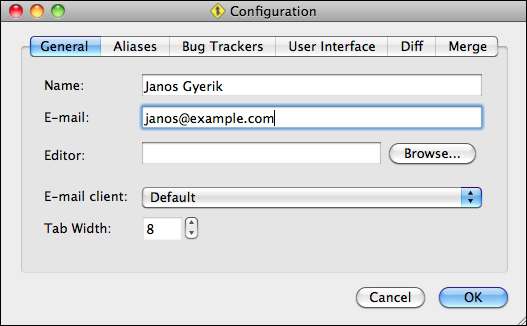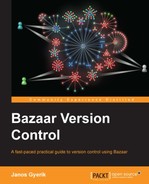Before we can really dive in, it is good to configure the following user settings:
email: This is the author information, which is recorded in each revisioneditor: This represents the default text editor used to write the revision log messages and edit files in Bazaar Explorer
These settings are stored in the bazaar.conf file in the Bazaar configuration directory, which you can find in the output of the bzr version command. You can view and edit the configuration using the command-line interface or Bazaar Explorer.
The author is part of the metadata recorded, together with the content of the revision. In Bazaar, the author is a string in the following format:
NAME <EMAIL>
For example, Janos Gyerik <[email protected]>.
You can check the current setting by running bzr whoami without any parameters:
$ bzr whoami Janos Gyerik <janos@testvm>
Depending upon your system, Bazaar may figure out a sensible default value based on your user account information. In this example, the e-mail address was auto-detected by Bazaar as my username in the system and the hostname of the system.
It is recommended that you use a real e-mail address in this setting, that collaborators can reach you by. You can update the setting by specifying the new value as a parameter. For example:
$ bzr whoami 'Janos Gyerik <[email protected]>'
You can change this setting anytime, however, this will only affect future revisions you record; the author information cannot be changed in the past revisions.
The bzr whoami command effectively shows or sets the value of the e-mail setting in the user configuration file.
In Bazaar Explorer, you can find the author settings in the Setup and personalize Bazaar tab's Configuration item, or by selecting Settings | Configuration | User Configuration. The most important are the Name and E-mail fields in the General tab:

The default editor is used to enter a log message when recording a revision, and when opening files in Bazaar Explorer for editing. It is stored in the editor setting in the user configuration file.
You can view the value of the setting by using the following command:
$ bzr config editor /usr/local/bin/edit
You can change the value of the setting by using the following command:
$ bzr config editor=/usr/local/bin/edit --scope=bazaar
Make sure to use a plaintext editor, such as Notepad or Notepad++ in Windows; TextEdit, TextMate, or TextWrangler in Mac OS X; gedit, gvim, or vim in GNU/Linux.
Another way to confirm and edit this setting is by using Bazaar Explorer in the same way as you would while editing the author information—in the Setup and personalize Bazaar tab, click on Configuration, or select Settings | Configuration | User Configuration in the Application menu.
